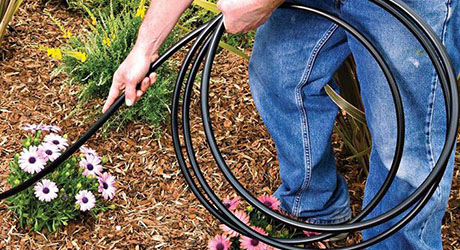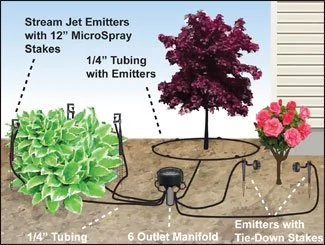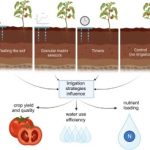Imagine transforming your garden into a thriving oasis, all while saving time, water, and effort. How does that sound?
If you’re tired of the constant hassle of hand-watering your plants or dealing with ineffective sprinkler systems, there’s a smarter solution waiting for you. Welcome to the world of drip irrigation systems—a game-changer for every gardening enthusiast. Setting up a drip irrigation system might sound technical, but it’s easier than you think.
In fact, with just a few simple steps, you can automate your watering routine and ensure your plants get the precise amount of hydration they need. You’ll not only conserve water but also promote healthier plant growth, ultimately leading to a more fruitful garden. Curious to find out how you can achieve this? Stick with us as we guide you through the step-by-step process of setting up your very own drip irrigation system. Whether you’re a seasoned gardener or just starting out, this guide is designed to make the process straightforward and stress-free. Ready to unlock the secret to a lush, low-maintenance garden? Let’s get started!

Benefits Of Drip Irrigation
Drip irrigation offers numerous benefits for gardeners and farmers alike. This efficient water delivery system targets the roots directly. It reduces water waste significantly. It’s ideal for maintaining healthy plants. Explore the advantages of drip irrigation below.
Reduced Water Usage
Drip irrigation minimizes water usage. It delivers water precisely to plant roots. This prevents unnecessary evaporation or runoff. Save water and cut costs.
Improved Plant Health
Plants receive consistent water supply. Drip irrigation ensures even moisture levels. This leads to healthier growth. Reduce stress on your plants.
Weed Control
Drip irrigation limits water to desired areas. This reduces weed growth. Less water reaches unwanted plants. Maintain a tidier garden.
Efficient Nutrient Delivery
Fertilizers can be delivered via drip systems. This ensures nutrients reach roots directly. Improve nutrient uptake in plants. Enhance growth and yield.
Flexible Installation
Drip systems suit various landscapes. They can be adapted for different terrains. Install in gardens, farms, or greenhouses. Customize according to need.
Choosing The Right Components
Setting up a drip irrigation system can save water and time. Choosing the right components is crucial for a successful installation. Selecting the right parts ensures your system runs efficiently. Understanding each component helps you make informed decisions. Let’s explore the essential components needed for a drip irrigation system.
Drip Tubing
Drip tubing carries water from the source to your plants. Choose tubing based on your garden’s size and layout. Flexible tubing works well for curves and corners. Ensure it’s durable for long-lasting use.
Emitters
Emitters control water flow to each plant. They come in various flow rates. Select emitters based on your plants’ water needs. Some emitters are adjustable for flexible watering. Place them near the plant’s root zone for best results.
Filters
Filters prevent debris from clogging your system. They are essential for maintaining water flow. Choose filters compatible with your water source. Regularly clean filters to ensure efficient operation.
Pressure Regulators
Pressure regulators manage water pressure in your system. High pressure can damage components. Regulators ensure consistent water flow. Select a regulator based on your system’s size and needs.
Connectors And Fittings
Connectors and fittings join components together. They ensure a secure and leak-free system. Choose connectors that fit your tubing size. Use fittings to navigate corners and slopes.
Timers
Timers automate your irrigation schedule. They ensure plants receive water at regular intervals. Choose a timer with easy-to-set programs. Timers help save water by preventing overwatering.
By selecting the right components, your drip irrigation system will perform efficiently. Proper component choice can make a significant difference in water conservation and plant health.
Step-by-step Installation
Installing a drip irrigation system can transform your garden’s health and efficiency. This guide offers a clear, step-by-step approach to setting up your system. You’ll find each step broken down into easy-to-follow instructions. Let’s dive into the details.
Step 1: Gather Your Materials
Start by collecting all necessary materials for your system. You’ll need tubing, emitters, connectors, and a timer. Check your local garden store for these supplies. Make sure to have enough for your entire garden area.
Step 2: Plan Your Layout
Sketch out your garden to map the irrigation layout. Identify plant beds and pathways. Determine where each emitter will be placed. This plan will guide your installation process.
Step 3: Install The Main Line
Lay the main tubing along your planned path. Use stakes to secure it to the ground. Cut the tubing to fit your garden’s dimensions. Ensure the main line reaches all planting areas.
Step 4: Add Emitters And Connectors
Attach emitters to the main line using connectors. Space them according to plant needs. Ensure each emitter is securely fastened. Test for leaks by turning on the water briefly.
Step 5: Set Up The Timer
Connect the system to a timer for automation. Set the timer for specific watering times. Adjust based on weather conditions and plant requirements. Regularly check the timer’s schedule for effectiveness.
Step 6: Test And Monitor
Turn on the system and observe its operation. Check for any leaks or blockages. Make necessary adjustments to ensure even water distribution. Regular maintenance will keep your system running smoothly.

Maintenance Tips
Setting up a drip irrigation system involves connecting hoses, installing emitters, and adjusting water flow. Regularly inspect for clogs and leaks, ensuring efficient water usage. Keep the system clean and check connections for wear to maintain optimal performance.
Maintaining a drip irrigation system is crucial to ensure its long-term efficiency and effectiveness. Neglecting maintenance can lead to clogs, leaks, and uneven watering, which can jeopardize the health of your plants. Regular checks and simple upkeep can keep your system running smoothly, saving you both time and water in the long run. Here’s how you can keep your drip irrigation system in top shape.Inspect For Clogs And Leaks
Check your system regularly for clogs and leaks. Clogged emitters can restrict water flow, leaving some plants thirsty. Leaks, on the other hand, can waste water and cause overwatering. A quick inspection once a month can help you catch these issues early.Flush The System
Flushing your irrigation system periodically helps remove any debris or sediment that might accumulate. Simply open the end cap of your drip line and let the water run through for a few minutes. This simple step can prevent clogs and maintain consistent water flow.Replace Damaged Parts
Over time, some parts of your irrigation system may wear out or get damaged. Keep an eye out for cracked pipes or broken emitters. Replacing these parts promptly can prevent larger issues from developing.Adjust For Seasonal Changes
Water needs change with the seasons. In the summer, your plants may need more water, while in the winter, less is often sufficient. Adjust your watering schedule accordingly to optimize your system’s efficiency.Monitor Water Pressure
Consistent water pressure is vital for a drip irrigation system to work effectively. Too much pressure can cause leaks, while too little can lead to insufficient watering. Use a pressure regulator if necessary to maintain an appropriate level.Keep An Eye On Plant Growth
As your plants grow, they may block emitters or shift the position of your drip lines. Check regularly to ensure your system is still correctly aligned and delivering water to the right spots. Adjust the lines as needed to accommodate plant growth. Taking these steps can extend the life of your drip irrigation system and enhance its performance. Have you faced any challenges with your irrigation system maintenance? Share your experiences and tips in the comments below!
Conclusion
Setting up a drip irrigation system is simple and rewarding. It saves water and nurtures plants efficiently. Follow steps carefully for best results. Choose quality materials for durability. Regularly check and maintain the system. Ensure no leaks and proper flow.
Adjust settings for different plant needs. Enjoy thriving gardens with less effort. Drip irrigation supports sustainable gardening practices. Experience healthier plants and reduced water bills. With patience and care, your garden will flourish. Start today and see the difference.


